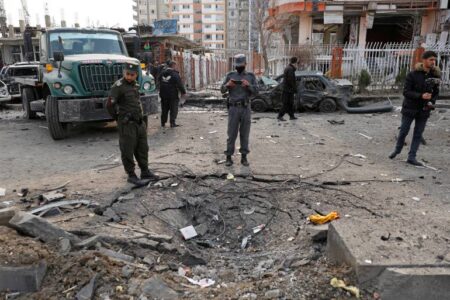
Three bombs in the Afghan capital Kabul killed at least ten people
Three bombs rattled the Afghan capital Kabul late Tuesday killing at least 10 people and plunging the city into darkness, an Afghan government spokesman said.
Two bombs exploded in quick succession in separate locations of a west Kabul neighborhood, killing at least 10 people and wounding a dozen others, said deputy Interior Ministry spokesman Said Hamid Rushan.
A third bomb heavily damaged an electrical grid station in north Kabul, said Sangar Niazai, a spokesman for the government power supply department.
The initial two bombings, both targeting minivans, happened in a mostly ethnic Hazara area of the capital, said Rushan.
The first exploded near the home of a prominent Hazara leader, Mohammad Mohaqiq, and in front of a Shiite mosque. Most Hazaras are Shiites. The second bomb also targeted a minivan but Rushan said details were still being collected.
Police cordoned off the two areas and investigators were sifting through the rubble.
No one claimed responsibility for the bombings but the Islamic State group affiliate operating in Afghanistan has previously declared war on minority Shiites, who make up roughly 20% of the majority Sunni Muslim nation of 36 million people.
The IS affiliate previously took responsibility for several attacks in May on Afghanistan’s power supply stations in Kabul and in several other provinces.
On May 8, a car bomb and two roadside bombs exploded outside the Syed-al-Shahada girls school, also in a predominantly Hazara neighborhood, killing nearly 90 people, many of them students. No one has yet claimed that attack but the U.S. blamed IS.
The attacks come as the United States wraps up its longest war by withdrawing the last of its 2,500-3,500 troops along with 7,000 allied NATO forces. The last soldiers are to be gone by Sept. 11 at the latest generating fears of increased chaos in a country already deeply insecure.
Violence has escalated in Afghanistan even as the United States struck a peace deal with the Taliban in February 2020 under the previous Trump administration.
The agreement called for the last of the U.S. and NATO troops to be out of the country by May 1. Instead, the withdrawal began on May 1 after U.S. President Joe Biden announced in mid-April America was ending its “forever war.” At the time, he declared terrorist groups like al-Qaida and the Islamic State had been sufficiently degraded and it was no longer necessary to keep thousands of troops deployed to Afghanistan.
Source: Seattle Times





